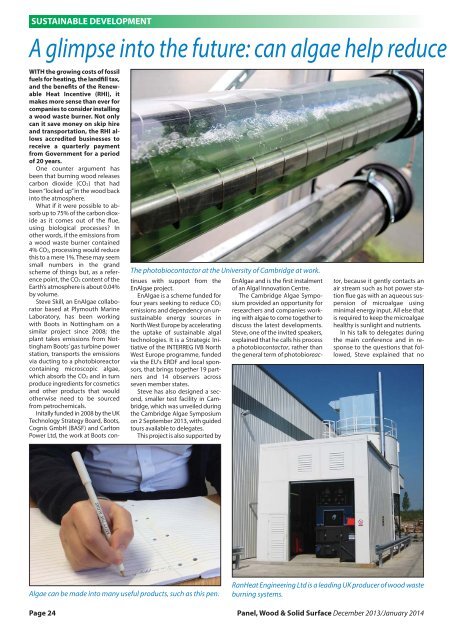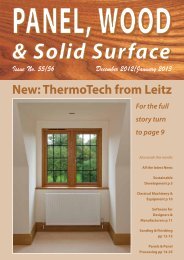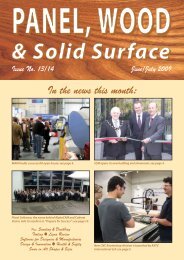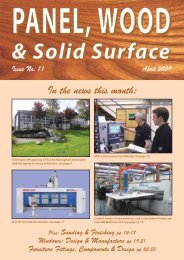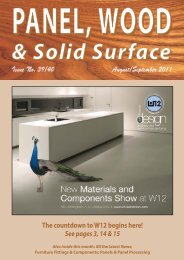December 2013/January 2014 - PAWPRINT PUBLISHING
December 2013/January 2014 - PAWPRINT PUBLISHING
December 2013/January 2014 - PAWPRINT PUBLISHING
Create successful ePaper yourself
Turn your PDF publications into a flip-book with our unique Google optimized e-Paper software.
SUSTAINABLE DEVELOPMENT<br />
A glimpse into the future: can algae help reduce<br />
The photobiocontactor at the University of Cambridge at work.<br />
WITH the growing costs of fossil<br />
fuels for heating, the landfill tax,<br />
and the benefits of the Renewable<br />
Heat Incentive (RHI), it<br />
makes more sense than ever for<br />
companies to consider installing<br />
a wood waste burner. Not only<br />
can it save money on skip hire<br />
and transportation, the RHI allows<br />
accredited businesses to<br />
receive a quarterly payment<br />
from Government for a period<br />
of 20 years.<br />
One counter argument has<br />
been that burning wood releases<br />
carbon dioxide (CO2) that had<br />
been “locked up” in the wood back<br />
into the atmosphere.<br />
What if it were possible to absorb<br />
up to 75% of the carbon dioxide<br />
as it comes out of the flue,<br />
using biological processes? In<br />
other words, if the emissions from<br />
a wood waste burner contained<br />
4% CO2, processing would reduce<br />
this to a mere 1%. These may seem<br />
small numbers in the grand<br />
scheme of things but, as a reference<br />
point, the CO2 content of the<br />
Earth’s atmosphere is about 0.04%<br />
by volume.<br />
Steve Skill, an EnAlgae collaborator<br />
based at Plymouth Marine<br />
Laboratory, has been working<br />
with Boots in Nottingham on a<br />
similar project since 2008; the<br />
plant takes emissions from Nottingham<br />
Boots’ gas turbine power<br />
station, transports the emissions<br />
via ducting to a photobioreactor<br />
containing microscopic algae,<br />
which absorb the CO2 and in turn<br />
produce ingredients for cosmetics<br />
and other products that would<br />
otherwise need to be sourced<br />
from petrochemicals.<br />
Initally funded in 2008 by the UK<br />
Technology Strategy Board, Boots,<br />
Cognis GmbH (BASF) and Carlton<br />
Power Ltd, the work at Boots continues<br />
with support from the<br />
EnAlgae project.<br />
EnAlgae is a scheme funded for<br />
four years seeking to reduce CO2<br />
emissions and dependency on unsustainable<br />
energy sources in<br />
North West Europe by accelerating<br />
the uptake of sustainable algal<br />
technologies. It is a Strategic Initiative<br />
of the INTERREG IVB North<br />
West Europe programme, funded<br />
via the EU's ERDF and local sponsors,<br />
that brings together 19 partners<br />
and 14 observers across<br />
seven member states.<br />
Steve has also designed a second,<br />
smaller test facility in Cambridge,<br />
which was unveiled during<br />
the Cambridge Algae Symposium<br />
on 2 September <strong>2013</strong>, with guided<br />
tours available to delegates.<br />
This project is also supported by<br />
EnAlgae and is the first instalment<br />
of an Algal Innovation Centre.<br />
The Cambridge Algae Symposium<br />
provided an opportunity for<br />
researchers and companies working<br />
with algae to come together to<br />
discuss the latest developments.<br />
Steve, one of the invited speakers,<br />
explained that he calls his process<br />
a photobiocontactor, rather than<br />
the general term of photobioreactor,<br />
because it gently contacts an<br />
air stream such as hot power station<br />
flue gas with an aqueous suspension<br />
of microalgae using<br />
minimal energy input. All else that<br />
is required to keep the microalgae<br />
healthy is sunlight and nutrients.<br />
In his talk to delegates during<br />
the main conference and in response<br />
to the questions that followed,<br />
Steve explained that no<br />
Algae can be made into many useful products, such as this pen.<br />
RanHeat Engineering Ltd is a leading UK producer of wood waste<br />
burning systems.<br />
Page 24 Panel, Wood & Solid Surface <strong>December</strong> <strong>2013</strong>/<strong>January</strong> <strong>2014</strong>


